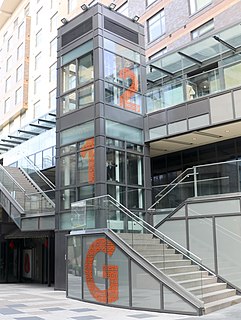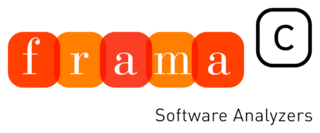Mesa is a programming language developed in the late 1970s at the Xerox Palo Alto Research Center in Palo Alto, California, United States. The language name was a pun based upon the programming language catchphrases of the time, because Mesa is a "high level" programming language.
Static program analysis is the analysis of computer software that is performed without actually executing programs, in contrast with dynamic analysis, which is analysis performed on programs while they are executing. In most cases the analysis is performed on some version of the source code, and in the other cases, some form of the object code.
In computing and computer programming, exception handling is the process of responding to the occurrence of exceptions – anomalous or exceptional conditions requiring special processing – during the execution of a program. In general, an exception breaks the normal flow of execution and executes a pre-registered exception handler; the details of how this is done depend on whether it is a hardware or software exception and how the software exception is implemented. Exception handling, if provided, is facilitated by specialized programming language constructs, hardware mechanisms like interrupts, or operating system (OS) inter-process communication (IPC) facilities like signals. Some exceptions, especially hardware ones, may be handled so gracefully that execution can resume where it was interrupted.
In computer science, specifically software engineering and hardware engineering, formal methods are a particular kind of mathematically rigorous techniques for the specification, development and verification of software and hardware systems. The use of formal methods for software and hardware design is motivated by the expectation that, as in other engineering disciplines, performing appropriate mathematical analysis can contribute to the reliability and robustness of a design.

In computer science, model checking or property checking is a method for checking whether a finite-state model of a system meets a given specification. This is typically associated with hardware or software systems, where the specification contains liveness requirements as well as safety requirements.
Cecil is a pure object-oriented programming language that was developed by Craig Chambers at the University of Washington in 1992 to be part of the Vortex project there. Cecil has many similarities to other object-oriented languages, most notably Objective-C, Modula-3, and Self. The main goals of the project were extensibility, orthogonality, efficiency, and ease-of-use.
In computing, an effect system is a formal system which describes the computational effects of computer programs, such as side effects. An effect system can be used to provide a compile-time check of the possible effects of the program.
Alma-0 is a multi-paradigm computer programming language. This language is an augmented version of the imperative Modula-2 language with logic-programming features and convenient backtracking ability. It is small, strongly typed, and combines constraint programming, a limited number of features inspired by logic programming and supports imperative paradigms. The language advocates declarative programming. The designers claim that search-oriented solutions built with it are substantially simpler than their counterparts written in purely imperative or logic programming style. Alma-0 provides natural, high-level constructs for building search trees.

Model-based testing is an application of model-based design for designing and optionally also executing artifacts to perform software testing or system testing. Models can be used to represent the desired behavior of a system under test (SUT), or to represent testing strategies and a test environment. The picture on the right depicts the former approach.
The Java Modeling Language (JML) is a specification language for Java programs, using Hoare style pre- and postconditions and invariants, that follows the design by contract paradigm. Specifications are written as Java annotation comments to the source files, which hence can be compiled with any Java compiler.
Baby Modula-3 is a functional programming sublanguage of Modula-3 programming language based on ideals invented by Martín Abadi. It is an object-oriented programming language for studying programming language design; one part of it is implicitly prototype-oriented, and the other is explicitly statically typed designed for studying computer science type theory. It has been checked as a formal language of metaprogramming systems. It comes from the Scandinavian School of object-oriented languages.

Frama-C stands for Framework for Modular Analysis of C programs. Frama-C is a set of interoperable program analyzers for C programs. Frama-C has been developed by the French Commissariat à l'Énergie Atomique et aux Énergies Alternatives (CEA-List) and Inria. It has also received funding from the Core Infrastructure Initiative. Frama-C, as a static analyzer, inspects programs without executing them. Despite its name, the software is not related to the French project Framasoft.
The ANSI/ISO C Specification Language (ACSL) is a specification language for C programs, using Hoare style pre- and postconditions and invariants, that follows the design by contract paradigm. Specifications are written as C annotation comments to the C program, which hence can be compiled with any C compiler.
In computer science, polymorphic recursion refers to a recursive parametrically polymorphic function where the type parameter changes with each recursive invocation made, instead of staying constant. Type inference for polymorphic recursion is equivalent to semi-unification and therefore undecidable and requires the use of a semi-algorithm or programmer supplied type annotations.

An aspect weaver is a metaprogramming utility for aspect-oriented languages designed to take instructions specified by aspects and generate the final implementation code. The weaver integrates aspects into the locations specified by the software as a pre-compilation step. By merging aspects and classes, the weaver generates a woven class.
In computer science, region-based memory management is a type of memory management in which each allocated object is assigned to a region. A region, also called a zone, arena, area, or memory context, is a collection of allocated objects that can be efficiently reallocated or deallocated all at once. Like stack allocation, regions facilitate allocation and deallocation of memory with low overhead; but they are more flexible, allowing objects to live longer than the stack frame in which they were allocated. In typical implementations, all objects in a region are allocated in a single contiguous range of memory addresses, similarly to how stack frames are typically allocated.
Extended static checking (ESC) is a collective name in computer science for a range of techniques for statically checking the correctness of various program constraints. ESC can be thought of as an extended form of type checking. As with type checking, ESC is performed automatically at compile time. This distinguishes it from more general approaches to the formal verification of software, which typically rely on human-generated proofs. Furthermore, it promotes practicality over soundness, in that it aims to dramatically reduce the number of false positives at the cost of introducing some false negatives. ESC can identify a range of errors which are currently outside the scope of a type checker, including division by zero, array out of bounds, integer overflow and null dereferences.
Gradual typing is a type system in which some variables and expressions may be given types and the correctness of the typing is checked at compile time and some expressions may be left untyped and eventual type errors are reported at runtime. Gradual typing allows software developers to choose either type paradigm as appropriate, from within a single language. In many cases gradual typing is added to an existing dynamic language, creating a derived language allowing but not requiring static typing to be used. In some cases a language uses gradual typing from the start.
Whiley is an experimental programming language that combines features from the functional and imperative paradigms, and supports formal specification through function preconditions, postconditions and loop invariants. The language uses flow-sensitive typing also known as "flow typing."
Dafny is an imperative compiled language that targets C# and supports formal specification through preconditions, postconditions, loop invariants and loop variants. The language combines ideas primarily from the functional and imperative paradigms, and includes limited support for object-oriented programming. Features include generic classes, dynamic allocation, inductive datatypes and a variation of separation logic known as implicit dynamic frames for reasoning about side effects. Dafny was created by Rustan Leino at Microsoft Research after his previous work on developing ESC/Modula-3, ESC/Java, and Spec#. Dafny is been used widely in teaching and features regularly in software verification competitions.



